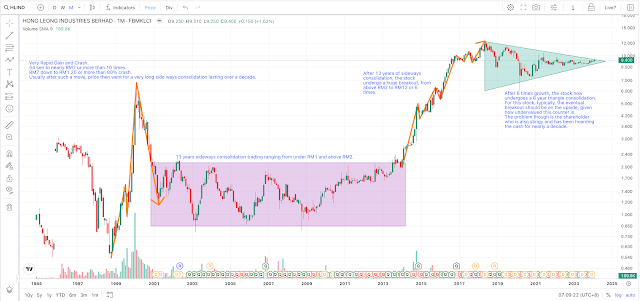Long term chart
Approaching LT support trend line going back to over 15-17 years old.
Fundamentals/Business Considerations
Past 10 years:
- RPS CAGR ~ 5.3% p.a. (decent i.e. C+)
- EPS CAGR ~ 7.3% p.a. (i.e. past 10 years management has worked to squeeze more profits from same revenue, decent i.e. B).
- DPS CAGR ~ 7.5% (close enough to EPS growth - it suggests nearly 100% dividend payout ratio - decent i.e. B).
- NAPS ~ 2.7% (suggesting that it does retain some earnings somehow due to differences between earnings vs cashflows. Decent C).
Based on past 10 years stats, this stock can be reasonably expected to grow roughly inline with long term CPI+GDP growth i.e. say 3%+4.5% ~ 7.5% which is close to its EPS/DPS growth. Clearly above average stock quality. (Overall Grade is say B-)
My personal prudent estimate of its long term dividend ~ 125 sen.
(TTM is 128 sen i.e. higher. Prior year 138 sen, i.e. price dips because TTM DY is lower than prior year).
My guess on a decent accumulation zone is around RM22.
This gives a decent initial Dividend Yield of 1.25/22 = 5.7%.
Additionally, this Dividend has 50/50 chance of growing at 7.5% per annum long term.
It's a business worth owning when the price is low, when pessimism is higher than normal.
Investment Targets
As usual, we consider Dividend Yield plus reasonable Price Gains.
1. Expected Dividend Yield around 5.5%-6% (say 5.5% for prudent).
2. I'm looking for a conservative 4% p.a. price gains over next 5 years. Allowing for 1% in and out commission, assuming a Buy Price of RM22, the target prices after year 1, 2, 3, 4, 5 in order to deliver 4% p.a. are as follows:
From the above long term chart, the highest price is higher than RM30.
To get 4% p.a. price gains alone in 5 years only requires the stock to exceed RM27.1.
This looks like a very high probability of happening over the next 5 years.
In short, this passes my criteria of beating my 9% p.a. benchmark return.
Target Position Size
My neutral position size is 3% capital. (roughly correspond to 33 diversified businesses).
I am currently slightly underweighted at 2.2% capital only. However, I also owned CARLSBG at similar sizes. I slightly prefer HEIM over CARLSBG. It's probably not so prudent to exceed 5% capital for both given the 33 diversified businesses.
Hence, I hope to be able to add 0.6% capital as price approaches my buy zone.
What if Price breaks below the long term trend line support?
My purchase is based on fundamentals/business considerations.
So, charts are mainly for indicative entry price, and give more colour on probably long term price gains with high probability.
Therefore, if price breaks below the long term trend line support drawn, I will not cut loss.
Instead, I'd be more interested to add more, to get my position here to be slightly higher than neutral (after price settles).
Summary
HEIM just reported its last quarter report.
It finished the year at a slightly weaker note, compared to a strong 2022 rebound after the economy reopened.
The company viewed the dip as a form of "market correction".
It is cautiously optimistic for 2024.
My gut feel is the company's guidance is about right.
It's not going to be a star performer in 2024.
But it is above average quality business.
It's the kind of company that I will consider owning in its entirity at RM22 and hold for at least 5 years.
I believe there is better than 50/50 chance, maybe as high as 80% chance, that it is able to deliver at least 9% p.a. over the next 5 years or longer.
I like it that it is a boring stock.
It means I can own this, together with my other 30+ investing stocks (excluding trading stocks) in my diversified portfolio, to grow my net worth slowly and safely.
My gut says very high odds of beating EPF over the next 5 years too.
However, nothing is certain in investing.
Hence, I am not planning to own this more than 3% of my capital, only because I already have CARLSBG too.



































